|
|
||||
| home > architetture | ||||
| QUA'VIRARCH.
The Gyeonggi-Do Jeongok Prehistory Museum |
||||
| Nel
gennaio 2006 il Gyeonggi Provincial Government della Corea ha bandito
un concorso internazionale di progettazione del Museo Preistorico GyeongGi-Do
Jeongok. 2.300.000 USD sono previsti per la realizzazione del complesso
dotato di spazi espositivi (1.350 mq), magazzini (500 mq), uffici (500
mq), spazi per la didattica (300 mq), spazi ricreativi (250 mq), impianti
elettrici e meccanici (400 mq), funzioni speciali (200 mq) e viabilità
interna (1.200 mq). I risultati del concorso sono stati resi noti nell'aprile
scorso. ARCH'IT presenta il progetto elaborato dallo studio olandese
di Casanova + Hernandez Architects
e quello dello studio americano Qua'Virarch diretto da Paul Preissner,
classificatosi secondo. Il primo gioca in maniera spettacolare con la
topografia del sito. Il terreno viene affettato crudamente, inserendovi
un corpo dalla geometria rigorosamente ortogonale dal cui interno il
visitatore può apprezzare una vasta parete lunga 90 metri e alta
10 che espone lo scuro basalto che caratterizza il terreno locale. Il
secondo è invece concepito in continuità con il landscape
del sito. Una sorta di "volume fibroso" che definisce
in maniera tutt'altro che mimetica la transizione dalle morbide curve
della natura alla forte artificialità della costruzione. [Paola
Giaconia] |
||||
| DESIGN
CONCEPT. The Gyeonggi-Do Jeongok Prehistory Museum is envisaged as an
extension of the surrounding terrain and archival sites, and as a fibrous
volume, which emerges from itself, expanding onto the site, ferociously
changing from a soft and natural surface (terrain) into a strong and
foreign material (building). |
[16aug2006] | |||
 |
Using
a policy to promote cultural and educational activities, our proposal
performs as an central character in the play, not only for the users
of the facility, but also for the entire culture of Korea; becoming
a new Center for the discovery and empathetic learning of history. The concept for museums of cultural prehistory, particularly those that organizational framing in the process of research, have changed. Our design proposes an open interconnected terracing of exhibition spaces. All rooms of exhibition are separated only through the platform circulation, while visibility is constantly maintained. This new form of curatorial framing allows the entire contents of the museum to be constantly appreciated from every position, reinforcing the magnitude of historical artifacts contained within. |
|||
 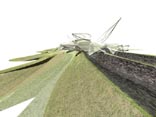
|
PROJECT
BRIEF. The given site for the Museum is situated on a naturally steep
terrain. For that reason, the design arose as the spatial continuation
of the landscape and its organic (somewhat monstrous) metamorphosis
into the building. The site of the building occupies the negotiation between extremes in topography. This allows for the landscape to appear uninterrupted by the project and to appear as though site and building are beautiful confluences of natural forces. DESIGN. The design scheme is based on an open and integrated platform interior. Every location within the museum is part of the continuous exhibition space, including the bldg plant room, archival storage, curatorial restoration, and basalt precipice. The levels are all integrated via a network of elevators, walkways, and stairs that create a continuity of circulation. The experience of the museum is navigating the exhibits, and seeing visible all the aspects (excavation, restoration, exhibition, artifact) of prehistory. 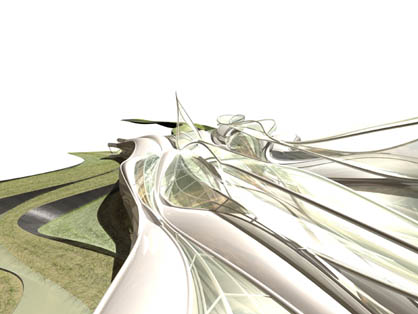
|
Early structural diagram. |
||
Inside the museum entry, the park is extended to form the public spaces that become transition areas between the park and the exhibition located on the floors above and below. Users access the building through gardens and four nubs which contain the Common Zone: Reception, Exhibit Halls, and Cafeteria; all integrated to the adjacent context of the museum park. This transitory area creates an imposing space that attracts and invites users of the building. Due to the muscularity of the landscaping of the plot, the building is a fibrous confluence of mass in which the cores/lifts have been distributed throughout allowing extensive views within the museum and out to the museum park. Open areas with panoramic views benefit the design of the building. The main reception hall distributes upwards to the next two levels: |
||||
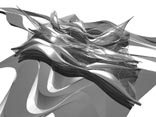 |
On
the first exhibition floor the beginning of the gallery exhibits emerge.
The artifacts area all displayed in shaped voluptuous cases to remove
any sense of comfort and allow the historical objects to be viewed as
if new. The main curatorial goal is to begin to reframe this history
as something solvent, something flexible, and certainly still alive.
This is a decided break from the traditional method of maintaining the
objects history as its only point of exhibition. The main triple height
space of the reception hall becomes the heart of the museum as well
as the investigation platform allowing for movement to all others. Plan 00. On the second exhibition floor, the zone for consultancy, study for students and a lecture room are distributed across the terrace towards the central, triple-height space housing 20,000 books. Skylights that run along the east-west axis of the building illuminate this hall. The building is conceived mainly in concrete with natural skylights emerging out of the roof folds to generate a pleasant ambient temperature throughout the library. STRUCTURE. The completeness of the project lies in its ability to produce architectural affect with the most basic of devices: its structure. A project propped up by expensive materials simply falls out of fashion, but a project created through an understanding of the delicate choreography of structural innovation aligned with programmatic intention produces the most captivating works in the world. |
 Plan 01. 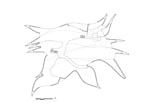 Plan 02. 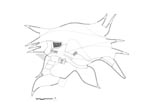 Plan B1.  Plan B2. |
||
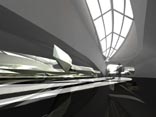 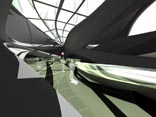   |
Our
proposal does just that; it is a simple system of concrete beams, and
columns woven into a beautiful net of seamless material in order to
imagine breathtaking interior views, and dignified exterior imagery.
The cohesiveness of structure allows the entire library not to feel
like a separation of floors, but as a unified body; or a complete being. The relative ease of construction allows the project to move forward at a quick speed with an economical mind toward cost. The project is effectively an interior concrete space frame of smooth concrete framing into a larger member reinforced concrete exterior. The thickening of the buildings exterior not only allows a transfer of loading to slim the interior structure, but also provides the ability to light the entire interior with the indirect wash of beautiful sun, without the risk of material damage or heat gain that comes from direct light. ENVIRONMENT. The reality of today's man-designed ecology is that the green attitudes we have towards our built environment have far more significance than the aesthetic decisions about them. Our world is rapidly approaching a self-made ecological collapse. How we respond with the next new projects in the world is critically important. Just as we are at a new height in aesthetic and engineering knowledge, we are also becoming acutely aware of the possibilities towards the development of green projects. The Gyeonggi-do Jeongok Prehistory Museum will be more than a landmark of architectural and curatorial significance, it will also stand in a select crowd of projects that claim to approach zero in their energy requirements. The beautiful natural settings of South Korea allow for a huge load of daily operational expenses to be taken using renewable sources, in this case: the sun, core earth temperature, and air movement. By creating such a porous interior arrangement, with extra light atriums and open floor plans, the museum has the ability to be lit in large part from natural daylight. An array of photo-voltaic roofing panels will allow the build-up of energy to be redistributed during darker hours, allowing for a smaller pull of the countries electrical grid.  Section East-West.  Section North-South. The thick exterior skeleton wall also allows for the natural maintenance of heating/cooling in the building by allowing for a slower heat gain/loss cycle during the course of the day. In addition to energy attitudes, plantings surrounding the museum park grounds, plaza, and roofing will allow for a natural garden, as opposed to a completely artificial greenscape, thereby reducing the load on city water, and labor. Materials within the museum; walls, floorings, ceilings, will be made of out recycled materials to again reduce any new load on the countries, and the world's material resources, and instead rely on the resources of our innovation and imagination. The use of recycled rubber tires and shoes in the production of flooring tiles will additionally assist for a dampening to the noise that often occurs in larger public spaces. The museum will stand alone as North Koreas foremost environmental museum, in an ecological, and material sense. Qua'Virarch |
|||
| QUA'VIRARCH.
The Gyeonggi-Do Jeongok Prehistory Museum |
||||
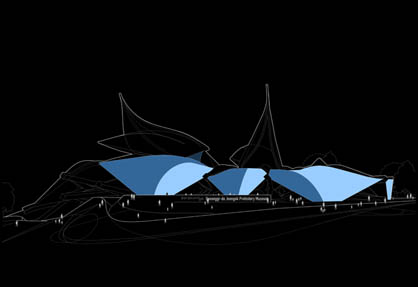 Elevation East. location: Jeongok, Gyeonggi Province, South Korea client: Gyeonggi Provincial Goverment project: Qua'Virarch principal in-charge: Paul Preissner, AIA project team: Matt Utley |
||||
| Paul Preissner is the founding principal of Qua'Virarch and has over 10 years of experience in the profession of architecture. Before founding Qua'Virarch, Mr. Preissner was a senior designer at Eisenman Architects; leading recent projects including the Arizona Cardinals Stadium (version2), and the 75oooSM City of Culture campus in Santiago Spain. He has also worked in the offices of Philip Johnson, Skidmore Owings and Merrill and Wood-Zapata. Mr. Preissner currently is writing about architecture as a choreography of visual and political effects and teaches studios and seminars at the University of Illinois-Chicago, the Southern California Institute of Architecture (SCI-Arc) and the School of the Art Institute of Chicago. He holds a Bachelor of Science (Architecture) from the University of Illinois, Urbana-Champaign (1996) and Masters in Architecture from Columbia University (2000). |
||||
| Per
candidare progetti laboratorio
|
|||||